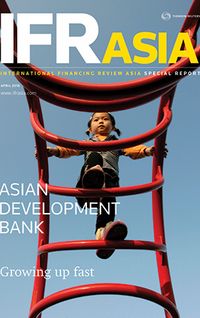Advancements in financial technology are opening up new opportunities for fast-growing Asian companies to finance trade and expansion, but pose new challenges for the region’s regulators. How can blockchain technology help power Asian development, and are Asia’s central banks ready to embrace virtual assets?
The ADB has so far been quiet on the topic of blockchain technology or virtual currencies, but the 2018 annual meetings promise to change that. Discussions on the future of finance feature high on the agenda, and ADB President Takehiko Nakao is due to debate the topic in a joint seminar with the IMF and the Philippines central bank on May 3.
The IMF, under Managing Director Christine Lagarde, is playing a leading role in calling for tighter regulation of digital finance. In a speech at the Boao Forum for Asia in April, in front of Chinese President Xi Jinping, she called on China to close a “regulatory gap” in the financial technology arena.
“Here in Asia, we see a blossoming of fintech industries. Yet the rise of fintech is revealing regulatory gaps which, if not closed both domestically and on a cross-border basis, can lead to systemic risks. You do not want to risk that. Instead, transform safely, and be more inclusive!”
Lagarde has warned repeatedly of the potential misuse of alternative financial systems – especially crypto-assets – for money-laundering and terrorist financing, and has put the IMF at the centre of efforts to coordinate a global regulatory response.
But she has also advocated for even-handed regulation that permits innovation.
“Just as a few technologies that emerged from the dot-com era have transformed our lives, the crypto-assets that survive could have a significant impact on how we save, invest and pay our bills,” she wrote in a blog post in April. “That is why policymakers should keep an open mind and work toward an even-handed regulatory framework that minimizes risks while allowing the creative process to bear fruit.”
The most promising new technology to arrive in the financial sector is undoubtedly the blockchain, or distributed ledger technology, where a secure record of transactions is kept in ‘blocks’ of data and protected by cryptography. The technology can allow automated verification between parties in a supply chain, reduce the need for intermediaries in a trade financing, or power smart contracts that execute themselves.
Commercial banks are already looking to use DLT to streamline their anti-money laundering checks and automate some transactions. Stock exchanges are studying its use for securities settlement.
Steven Beck, who heads the ADB’s popular Trade Finance Programme, wrote in December that a lack of global standards was preventing blockchain technology from helping SMEs access financing.
“The hype is fun and dreaming is important, but to catch up with reality we need to develop some basic infrastructure,” he wrote.
Beck advocates the use of digital standards for trade and steps to encourage the digitisation of supply chains, and has called for “a global harmonized identity for all companies, large and small” to simplify transparency and due diligence processes.
Central banks have also begun to explore the use of new technology for their own digital currencies.
The People’s Bank of China is widely seen as the most likely Asian central bank to be first to launch a digital currency. The PBoC has been studying the idea since at least 2014, even as regulators have clamped down on trading in crypto-currencies and initial coin offerings. Then central bank governor Zhou Xiaochuan said in March that the digital currency would be used only for payments and would have no effect on monetary policy, heading off speculation that it would be an alternative virtual asset.
Elsewhere, the Bank for International Settlements warned in a report in March that “a general purpose central bank digital currency could impact bank deposits, a major source of funding for commercial banks, with implications for financial stability”. But it said a digital currency showed promise for wholesale payments, potentially making the settlement of securities and FX transactions more efficient.
Lagarde, in a speech at the Bank of England last year, outlined a future where virtual currencies could be more stable than the central banks’ traditional paper bills.
“In many ways, virtual currencies might just give existing currencies and monetary policy a run for their money,” she said. “The best response by central bankers is to continue running effective monetary policy, while being open to fresh ideas and new demands, as economies evolve.”
To see the digital version of this roundtable, please click here
To purchase printed copies or a PDF of this report, please email gloria.balbastro@tr.com


